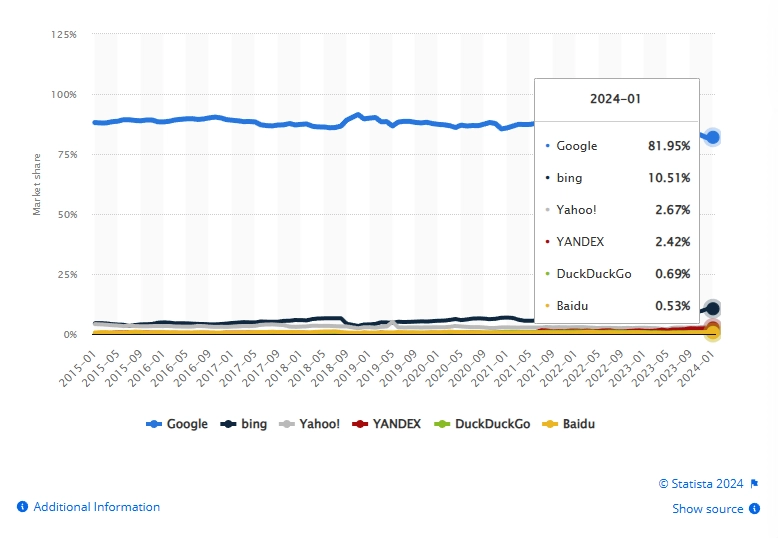Today, businesses with a website will effectively win market over business without website, especially in 2024.
In this guide, you will learn about website and impact to your business.
Let's dive in
In this article:
- Definition of website
- What is web server and web page?
- What is the type of website?
- What is landing page in website?
What is website?
A website is a digital platform that consists of a collection of interlinked web pages, which are accessible via the Internet. It serves as a virtual space where individuals, businesses, or organizations can establish an online presence, share information, offer products or services, and connect with users globally.
Websites are typically accessed through a web on devices such as laptops, smartphones, or tablets, by entering the website's address (URL) in the address bar.
Websites can serve various purposes, including providing educational resources, facilitating networking through online communities, and enabling real-time communication on social media platforms.
They can be categorized into different types, such as static websites, which have fixed content, and dynamic websites, which can be updated regularly.
Why is website important?
In essence: web is a digital storefront for your business.
It's one of digital marketing for business owners to level-up their marketing efforts. Website marketing is suitable for any business industry.
According to Statista, Google process over 8.5 billion searches per-day. Besides Google search engine, there is more search engine available today such as Bing, DuckDuckGo and other.

A high-quality website can be effective for you to generate more sales through lead and online sales (like eCommerce), especially if you rank on Google with SEO services, thus allowing your website to appear the first page of Google or higher as it shows your website when potential clients search for the services you provide.
Difference between a website and web pages
A website consists of single or multiple web pages. You can have multiple pages for a single website with a structured content and information or a one-page website (also known as single-page website) with multiple sections.
Single-page website (often called as a landing page), all information and page sections with great user interface into a single web page. This method will cause your website slow loading with heavy content and long scrolling.
But with multi-page website, you just structured every content and intent into each web pages. It will also affect your website address (domain)
Example:
- yourdomain.com
- yourdomain.com/our-services
- yourdomain.com/contact-us
Each page should have unique information and focus.
Difference between a website and web servers
Web server is a server that will host your website. It also known as web hosting, hosting, or private web hosting. You can build local or offline website and only accessible with your own local network and computer however, but with hosting, you are making your business website online and accessible through any web browser. Website is the content for user and server is the core component to bring your site online.
Essential components of a website
Below are required components for website to operate:
Domain names
A domain name is a human-readable address used to identify a specific location on the internet. It allows users to access websites easily without having to remember complex numerical IP addresses.
A domain name typically consists of two parts: the ** name** (which represents the brand or purpose of the website) and a top-level domain (TLD), such as .com, .org, or .net or country code top-level domain (ccTLD).
Examples of Domain Names
- www.google.com - The site name is "google," and the TLD is ".com."
- wikipedia.org - The site name is "wikipedia," and the TLD is ".org."
- example.net - The site name is "example," and the TLD is ".net."
- vetter.my - The site name is "vetter," and the ccTLD is ".my."
- harvard.edu - The site name is "harvard," and the TLD is ".edu," which is typically used for educational institutions.
A well-chosen domain name is crucial for branding and can enhance a website's visibility and accessibility. Fun fact, .com is common domain till these days.
If you are looking for custom domain for your email such as me@yourdomain.com, then you will need to get domain and email services like Proton.
Web Hosting
Web hosting is an online service that provides the infrastructure and technology needed to store and manage a website's files and data, making it accessible on the internet. Web hosts are specialized computers, often referred to as servers, located in remote data centers.
They all the necessary resources for a website, including images, videos, text, and databases, allowing users to access this content through web browsers.
The selection of a reliable web hosting service is crucial for the performance, uptime, and security of a website. Different types of web hosting are available, such as shared hosting, Virtual Private Servers (VPS), dedicated hosting, and cloud hosting, each catering to various needs and budgets.
For instance, shared hosting is typically cost-effective and suitable for small websites, while dedicated hosting offers exclusive resources for larger, high-traffic sites. A dependable web host ensures minimal downtime, high-speed access, and strong security measures to protect the website and its data.
Website content and structure
This part is your website marketing. A high-quality content will generate more incoming lead to your business and well-structured content will help you to rank better on search engine. Both can be managed with Content Management System (CMS).
What is Content Management System?
A Content Management System (CMS) is a software that's installed on your web server to manage, update, and modify content on your site. If you require third party service and compelling features, you can integrate them through your website CMS.
WordPress is one of the well-known CMS for reliable and efficient system. Depending on your budget, choosing a managed WordPress hosting is recommended compared to shared server.
Examples of website content management systems:
- WordPress
- Webflow
- Drupal
- Joomla and many more.
Website Content
Website content refers to the information presented on the website that's depending on your design inspiration, which can include:
- Text: Written information that informs, guides, or influences visitors. This can include articles, product descriptions, blogs, and more.
- Images: Visual elements that enhance the information and make it more engaging. High-quality images can significantly improve user experience.
- Videos: Multimedia content that can explain concepts, products, or provide entertainment. Videos often keep visitors engaged for longer periods.
- Audio Files: Sound content like podcasts, audio recordings or music that can provide additional information or entertainment value.
- Interactive Elements: Features like animations, forms, and interactive media that can engage users and encourage them to interact with the site.
- Well-Optimized Articles: Content that is designed not only for user engagement but also for search engine optimization (SEO), helping improve visibility on search engine result pages (SERPs).
Good content and user-friendly interface (UI) are essential for attracting visitors, keeping them on the site, and encouraging repeat visits.
Website Structure
Website structure refers to the organization and layout of the site, which includes:
- Home Page: The main entry point that sets the tone for the website and provides links to other important pages.
- Navigation Structure: The arrangement of pages and links that guide users through the website. This often involves navigation menus that help users find information easily.
- Layout: The visual arrangement of content on each page, including text, images, and multimedia elements. A well-designed layout enhances user experience.
- Page Hierarchy: The logical organization of content, usually from general to specific, which helps users understand the relationship between different pages and topics.
- Internal Linking: Hyperlinks within the website that connect related content, improving navigation and search engine optimization.
- Responsive Design: Ensures that the website is usable on various devices (desktops, tablets, smartphones) by adapting the layout and content accordingly.
A well-structured website allows for easier navigation and a better overall user experience, ensuring that visitors can find and engage with the content they are looking for.
Type of websites
There is various website out there from portfolio website, brochure site, sales page and membership site.
Below is comparison of the core type of website with static and dynamic website:
Static websites
A static website is a type of website composed of fixed content that does not change unless manually updated.
It consists of pre-written web pages that are delivered to the user exactly as they are stored on the server. Typically coded in Hypertext Markup Language (HTML) and styled with Cascading Style Sheets (CSS), static websites display the same information to all visitors regardless of their device, browser, or location.
Static websites are generally straightforward and cost-effective to create and host, as they do not require server-side processing or complex database management.
They are commonly used for purposes such as company profile pages, personal portfolios, and other informational sites where content does not need to be frequently updated or interactive.
While they may lack the dynamic features of more complex websites, static sites provide a reliable online presence for users seeking to convey consistent information.
Dynamic websites
A dynamic website is a type of website where the content displayed on the page is constantly changing or updating.
Unlike static websites, which present fixed information that remains the same until manually updated, dynamic websites generate content in real-time based on user interactions, preferences, or other variables.
Dynamic websites typically use server-side scripting languages (such as PHP, ASP.NET or Java) to build web pages on the fly, meaning that the HTML is created dynamically at the time of the user's request.
This allows the website to deliver personalized content, such as social media website with relevant content or the latest news articles on a news site, search results for a specific query, or user-specific information in web applications.
Key features of dynamic websites include:
- Real-time updates: Content can change frequently based on database queries, user actions, or external data sources.
- User interactivity: They often incorporate forms, interactive elements, and user logins that allow for more engagement and personalization.
- Database integration: Dynamic websites typically draw on databases to retrieve and display information, which allows for a vast amount of content that can be managed efficiently.
- Flexibility: They can adapt to different user needs, showing different content to different users based on their interactions.
Overall, dynamic websites provide a more interactive and engaging experience compared to static websites, making them suitable for applications like e-commerce platforms, social media sites, and news portals.
Static vs dynamic site
Depending on your business goals, each type of website has their own unique advantages and requirements. Smaller site can run well on small server while bigger site with complex features will require bigger server to run smoothly.
Below are some of website type examples:
Blog website
A blog website is a specific type of dynamic website focused primarily on sharing written content through articles or blog posts. Blogs can cover a wide range of topics and serve various purposes, including personal journaling, professional commentary, and niche-specific discussions.
Key characteristics of a blog website include:
- Content Structure: posts are usually displayed in reverse chronological order, meaning the most recent posts appear at the top. This format allows readers to easily access the latest information.
- Interactivity: Blogs often encourage reader engagement through features like comments, allowing visitors to share their thoughts, ask questions, and foster discussions around the content. This interaction helps build a sense of community among readers.
- Regular Updates: Blogs are dynamic, meaning they are frequently updated with new content. This keeps the information fresh and relevant, which is particularly important for retaining audience interest.
- Diverse Topics: Blogs can cover various subjects, from personal experiences and lifestyle tips to professional advice and industry insights. This versatility allows individuals, businesses, and organizations to express their ideas and share knowledge with their audience.
- Integration with Larger Websites: A blog can also be a section of a larger website, such as a business site. For example, companies often maintain a blog to educate users about their products, share industry news, or provide insights into their services.
In summary, a blog website is a dynamic platform dedicated to the publication of written content that encourages user interaction and community building, making it an effective tool for sharing information and engaging with an audience.
E-commerce sites
An eCommerce website is a digital platform specifically designed for buying and selling products or services online. These sites facilitate online by providing features that enable users to browse products, add items to a shopping cart, and complete purchases through secure payment processing. Key components of eCommerce websites include:
- Product Listings: Detailed pages showcasing the products or services available for sale, often including images, descriptions, prices, and specifications.
- Shopping Cart: A virtual cart that allows users to collect and review items they wish to purchase before proceeding to checkout.
- Secure Payment Gateway: Systems in place to handle transactions safely, ensuring that customers' payment information is protected.
- Order Management: Features that enable businesses to track orders, manage inventory, and handle logistics and shipping.
- User-Friendly Navigation: An interface designed for easy browsing, allowing customers to search for products with ease and find what they need quickly.
- Customer Support: Options for customers to receive assistance, whether through FAQs, chat features, or contact forms.
Popular examples of eCommerce websites include Amazon, eBay, and individual stores powered by platforms like WooCommerce or Shopify. These sites prioritize customer convenience, offering various payment options and often providing product reviews to aid in purchasing decisions.
Overall, eCommerce websites serve as online storefronts that enable businesses to reach a broader audience and facilitate seamless online shopping experiences for consumers.
Education website
An educational website is a type of site designed to provide content that aids in learning and education. These websites can include a variety of resources such as courses, academic articles, research papers, and interactive tools like quizzes.
They are often associated with schools, universities, or educational institutions, ensuring that the information is reliable and vetted for accuracy. Educational websites may present content through various mediums, including text, photos, videos, and audio, to the learning experience.
A prominent example of an educational website is Coursera, which offers access to thousands of courses provided by universities and other educational organizations.
Corporate website
A corporate website (often recognized as business site or informational website or brochure website) is a type of website created by a company or organization to share information about itself.
It often includes details about the company's achievements, the products or services it offers, and its overall mission.
The main goal of a corporate website is enhancing the company’s reputation and provide information to customers, partners, and potential clients.
Purpose of website
The purpose of a website is to achieve specific goals based on its type. Here are the primary purposes of the different types of websites outlined in the background information:
Personal Website or portfolio website:
The main purpose is to establish and enhance personal branding. It serves as a platform for individuals to showcase their expertise, share their stories, and present their work.
Personal websites help individuals communicate their knowledge in specific fields and connect with potential clients or employers.
Business website
The purpose of a commercial website is to serve as a digital storefront that provides information about products or services, the team, and the brand message for local and online business. It aims to attract customers, facilitate communication, and ultimately lead to sales.
Business websites are designed to enhance brand visibility and serve as a touchpoint for potential customers to engage with the business.
Ecommerce website
The primary purpose of e-commerce websites is to enable businesses to sell products and services online. They provide a platform for customers to browse, select, and purchase items conveniently.
E-commerce websites cater to the growing demand for online shop and aim to create a seamless shopping experience for users.
Overall, websites serve to improve brand identity, increase visibility, facilitate communication, and provide convenience to customers in various contexts. They are essential tools for both individuals and businesses in today’s digital landscape.
But what does it cost? Check out our other article about website price.



